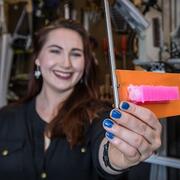
Fish locomotion is characterized by waves of muscle electrical activity that proceed from head to tail, and result in an undulatory pattern of body bending that generates thrust during locomotion. However, isolating and studying these movements in live fishes is difficult and scientists often use robotic models instead. Most robotic fish models are either passive, flapping models that are simple but don't actively swim, or active, hard models that actively swim but take forever to construct. PhD candidate Zane Wolf (Lauder Lab) worked with lab members and colleagues at Max Plank to study fish undulatory locomotion using a soft, pneumatically-activated robot called the Pneufish, which falls somewhere between the two previously studied models - both easy to make and actively swims.
Wolf and colleagues swam the pneufish across a large parameter space and examined key parameter interactions, particularly focusing on the effects of actively modulating stiffness in the pneufish model, a difficult task in studies using previous robotic models. Researchers discovered the pneufish swims best at higher frequencies when stiffness is also changed. Only changing one or the other (frequency or stiffness) did not show an increase in swimming performance. Their work yields valuable insights into how fish can modulate their own biomechanics to swim efficiently at higher or lower speeds. The study is published in Bioinspiration & Biomimetics.
